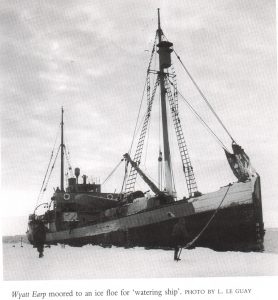- Author
- Ellis, John
- Subjects
- History - general, Ship histories and stories, History - post WWII
- Tags
-
- RAN Ships
- HMAS Wyatt Earp, HMAS Wongala
- Publication
- March 2012 edition of the Naval Historical Review (all rights reserved)
John Ellis joined the RAN College in 1953; this was followed by the then traditional training in HMAS Swan, Britannia RN College Dartmouth and the RN Engineering College Manadon. He served in HMA Ships Melbourne, Sydney, Perth and Hobart. Service ashore included Garden Island Dockyard and the Engineering School at HMAS Cerberus. PNF service was followed by RANR service with the Sydney Port Division. Interest in the Antarctic developed from a Christmas gift in 1950 of South with Scott by E.R.G.R. Evans. He saw his first icebergs whilst sailing from Hobart to Rio in HM Bark Endeavour replica in 2002. Three years later he sailed to the Ross Sea in an icebreaker and visited the huts used by Scott, Shackleton and Borchgrevink. He plans to visit Mawson’s Hut in February 2012.
Anzac, Sydney, Perth – these are some of the familiar names of HMA Ships with the origins of the names well known on every mess-deck. But who has heard of HMAS Wyatt Earp? Pull up a bollard and I’ll tell you a story.
Australia has had an interest in the Antarctic since the early 19th century. Initially, this interest was commercial when Sydney-based sealers ventured into Antarctic waters. Such voyages led to the discovery of Macquarie Island by Frederick Hasselburgh in 1810. Several voyages of discovery and science used Sydney, Melbourne and Hobart as support ports during the 19th century. Those who did land went ashore on islands off the Antarctic coast. The Royal Society of Victoria made an unsuccessful attempt to stimulate interest in the Antarctic in 1886. The first party to land on the Antarctic mainland was led by Henrik Bull, a Norwegian who was living in Melbourne in the 1890s. His party included another Norwegian, Carstens Brochgrevink, who had lived in Australia since 1888. Bull’s party landed at Cape Adare in January 1895.
Borchgrevink returned to Australia, determined to lead a party to winter over at Cape Adare. His expedition was sponsored by a British magazine publisher on the condition it be named the British Antarctic Expedition. Borchgrevink’s party of nine included Louis Bernacchi, a scientist from Tasmania, who later joined Commander Scott’s 1901-4 expedition. The party landed in January 1899 and departed a year later, the first to over winter ashore in Antarctica. Their hut remains at Cape Adare with a few open days each season.
Ernest Shackleton’s expedition of 1907-09 included four from Australia. Professor Edgeworth David, Dr Douglas Mawson and Leo Cotton were part of the scientific staff and Bertram Armytage was in charge of the ponies. David, Mawson and MacKay, a Scot, sledged to the South Magnetic Pole in 1909 while Shackleton strove unsuccessfully for the South Pole. Captain Scott returned to Antarctica in 1911 for his second attempt to reach the South Pole. His scientific party included two Australians, Griffith Taylor and Frank Debenham. Mawson’s experience encouraged him to mount his own expedition. In 1911 he sailed from Hobart and established two bases along the coast due south of Australia to support sledging expeditions to the east, south and west of each base. He returned to Adelaide in 1913 having made a significant contribution to knowledge of Antarctica.

Mawson was knighted for his achievements and returned to the Antarctic with two voyages in 1929-30 and 1930-31. The voyages coasted Antarctica and touched at Macquarie Island, Heard Island and the Kerguelen Islands. On Proclamation Island Mawson claimed in the name of King George V all lands between longitudes 47º E and 173º E and south of latitude 65º S.
A British Order-in-Council of 1933 acknowledged this claim, based on territory between 45º E and 160º E and south of latitude 60º S, but excluding Adélie Land, the sliver of the French claim. The Order placed the region under the control of Australia. It was enacted later in 1933 and proclaimed in 1936.
The Depression, then World War II precluded any further work by Mawson in Antarctica. In October 1945 he began lobbying the Federal Government to continue research and exploration within the territory he had claimed in 1930. He warned that should Australia fail to do so, the United States would dominate future events in the Antarctic, even though they had not made a territorial claim. He also proposed that Australia should lay claim to Heard Island. Although sighted in 1835, it was named after Captain John Heard, an American sealer en route from Boston to Melbourne in 1853. Even so, there had been no official claim.




